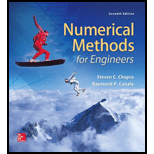
Concept explainers
The flow
where
(a) Given the parameters n
(b) Repeat part (a), but include the cost of excavation. To do this minimize the following cost function,
where
(c) Discuss the implications of your results.
(a)
To calculate: The values of that will minimize the wetted perimeter P if the Manning equation of flow Q
can be written as
Answer to Problem 19P
Solution:
The values of
that will minimize the wetted perimeter P is
respectively.
Explanation of Solution
Given Information:
The Manning equation of flow Q
can be written as
where n is Manning roughness coefficient,
is cross-sectional are of channel
is given by
where P is wetted perimeter and it is defined by
where H is depth
and the parameters value are given as
Calculation:
Consider the equation,
The constrained can be written as,
This problem can be solved out by Linear programming formulation.
To minimize the wetted perimeter P function with the given constraint, the excel solver can be used.
The excel solver steps are,
Step 1. Initiate quantity
and then write the parameter as shown below,

Step 2. Apply the formula in
as shown below,

Step 3. Apply the formula in P as shown below,

Step 4. Apply the formula in R as shown below,

Step 5. Apply the formula in Qmanning as shown below,
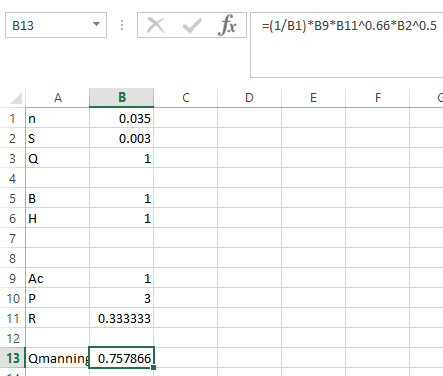
Step 6. Go to DATA and then click on Solver. This dialog box will appear.
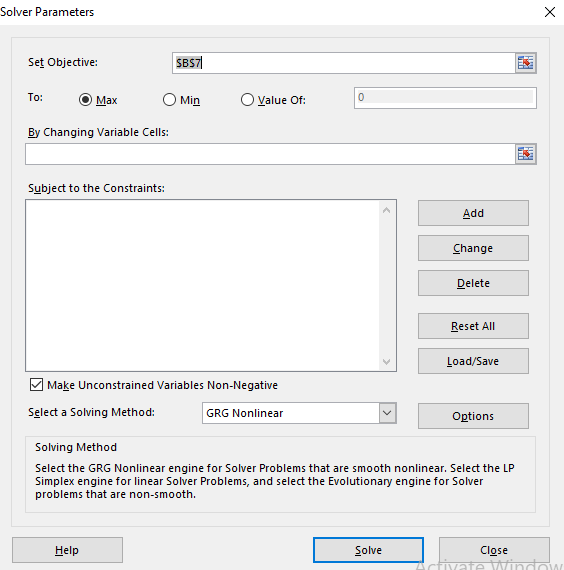
Step 7. Select the set objective, min, changing variable and then add,

Step 8. Click OK then this dialog box appears.

Step 9. Click on Solve and then OK.
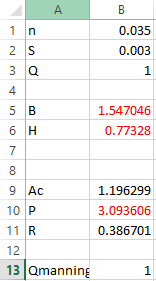
Hence, the values of
that will minimize the wetted perimeter P is
respectively.
(b)
To calculate: The values of
that will minimize the excavation cost function
is
and cost factor for lining
if the Manning equation of flow Q
can be written as
Answer to Problem 19P
Solution:
The values of
that will minimize the cost function P is
respectively.
Explanation of Solution
Given Information:
The Manning equation of flow Q
can be written as
where n is Manning roughness coefficient,
is cross-sectional are of channel
is given by
where P is wetted perimeter and it is defined by
where H is depth
and the parameters value are given as
Calculation:
Consider the function,
The constrained can be written as,
This problem can be solved out by Linear programming formulation.
To minimize the cost function with the given constraint, the excel solver can be used.
The excel solver steps are,
Step 1. Initiate quantity
and then write the parameter as shown below,

Step 2. Apply the formula in
as shown below,

Step 3. Apply the formula in P as shown below,

Step 4. Apply the formula in R as shown below,

Step 5. Apply the formula in Qmanning as shown below,

Step 6. Apply the formula in Cost as shown below,

Step 7. Go to DATA and then click on Solver. This dialog box will appear.

Step 8. Select the set objective, min, changing variable and then add,

Step 9. Click OK then this dialog box appears.

Step 10. Click on Solve and then OK.
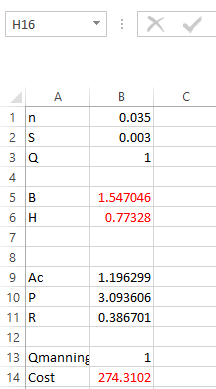
Hence, the values of
that will minimize the cost function is
respectively.
(c)
The implication of the result obtained in part (a) and part (b).
Answer to Problem 19P
Solution:
This can be interpreted that both the excavation and limiting cost can be minimized simultaneously by considering the bottom width B that is twice the length of each vertical side H.
Explanation of Solution
To interpret the result, first consider the constraint equation,
And,
On further simplification,
As
are dependent on B and H, thus both have minimized.
Thus, the excavation cost function
is minimized and as excavation cost C is directly proportional to cross-sectional area.
Hence, both the excavation and limiting cost can be minimized simultaneously by considering the bottom width B that is twice the length of each vertical side H as obtained in part (a) and (b) as
Want to see more full solutions like this?
Chapter 16 Solutions
Numerical Methods for Engineers
 Advanced Engineering MathematicsAdvanced MathISBN:9780470458365Author:Erwin KreyszigPublisher:Wiley, John & Sons, Incorporated
Advanced Engineering MathematicsAdvanced MathISBN:9780470458365Author:Erwin KreyszigPublisher:Wiley, John & Sons, Incorporated Numerical Methods for EngineersAdvanced MathISBN:9780073397924Author:Steven C. Chapra Dr., Raymond P. CanalePublisher:McGraw-Hill Education
Numerical Methods for EngineersAdvanced MathISBN:9780073397924Author:Steven C. Chapra Dr., Raymond P. CanalePublisher:McGraw-Hill Education Introductory Mathematics for Engineering Applicat...Advanced MathISBN:9781118141809Author:Nathan KlingbeilPublisher:WILEY
Introductory Mathematics for Engineering Applicat...Advanced MathISBN:9781118141809Author:Nathan KlingbeilPublisher:WILEY Mathematics For Machine TechnologyAdvanced MathISBN:9781337798310Author:Peterson, John.Publisher:Cengage Learning,
Mathematics For Machine TechnologyAdvanced MathISBN:9781337798310Author:Peterson, John.Publisher:Cengage Learning,






